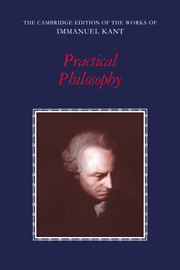Book contents
- Frontmatter
- Contents
- General editors' preface
- Preface
- General introduction
- Review of Schulz's Attempt at an introduction to a doctrine of morals for all human beings regardless of different religions (1783)
- An answer to the question: What is enlightenment? (1784)
- On the wrongfulness of unauthorized publication of books (1785)
- Groundwork of The metaphysics of morals (1785)
- Review of Gottlieb Hufeland's Essay on the principle of natural right (1786) [translated and edited by Allen Wood]
- Kraus's review of Ulrich's Eleutheriology (1788)
- Critique of practical reason (1788)
- On the common saying: That may be correct in theory, but it is of no use in practice (1793)
- Toward perpetual peace (1795)
- The metaphysics of morals (1797)
- On a supposed right to lie from philanthropy (1797)
- On turning out books (1798) [translated and edited by Allen Wood]
- Editorial notes
- Glossary
- Index of names
- Index of subjects
Review of Schulz's Attempt at an introduction to a doctrine of morals for all human beings regardless of different religions (1783)
Published online by Cambridge University Press: 05 June 2012
- Frontmatter
- Contents
- General editors' preface
- Preface
- General introduction
- Review of Schulz's Attempt at an introduction to a doctrine of morals for all human beings regardless of different religions (1783)
- An answer to the question: What is enlightenment? (1784)
- On the wrongfulness of unauthorized publication of books (1785)
- Groundwork of The metaphysics of morals (1785)
- Review of Gottlieb Hufeland's Essay on the principle of natural right (1786) [translated and edited by Allen Wood]
- Kraus's review of Ulrich's Eleutheriology (1788)
- Critique of practical reason (1788)
- On the common saying: That may be correct in theory, but it is of no use in practice (1793)
- Toward perpetual peace (1795)
- The metaphysics of morals (1797)
- On a supposed right to lie from philanthropy (1797)
- On turning out books (1798) [translated and edited by Allen Wood]
- Editorial notes
- Glossary
- Index of names
- Index of subjects
Summary
Introduction
Kant's review of Part I of Johann Heinrich Schulz's work (the full title of which is given in the text of the review) was published in a Königsberg journal, Rässonirenden Bücherverzeichnis. Part I of Schulz's work, like Kant's review of it, appeared in 1783. Part II was published in the same year, whereas Parts III and IV did not appear until 1790. The dates are of interest.
As for Kant's review, it is worth noting that he wrote it shortly before the Groundwork of the Metaphysics of Morals. A reviewer, Kant says, should first present briefly the author's position and then judge the work as a whole. Kant's judgment might profitably be compared with Part III of the Groundwork.
Schulz's career is of interest in the context of political events in Prussia. He was a preacher, in Gielsdorf, whose defiance of the ecclesiastical establishment extended from his personal appearance to his views on the relevance of orthodox religion to the relation of subject and sovereign. His refusal to wear a wig while preaching to his congregation earned him the nickname Zopfschulz (“pigtail-Schulz”). Such behavior was symptomatic of the philosophic position that made him suspect to the church authorities. Frederick the Great had protected Schulz from prosecution by the Brandenburg Consistory, but he was brought to court under the religious edict drawn up by Frederick William II and his minister Wöllner. Although the judges found Schulz not guilty of contradicting the teachings of Christianity, the king reversed their verdict, fined the judges, and dismissed Schulz from his appointment.
- Type
- Chapter
- Information
- Practical Philosophy , pp. 1 - 10Publisher: Cambridge University PressPrint publication year: 1996
- 1
- Cited by



